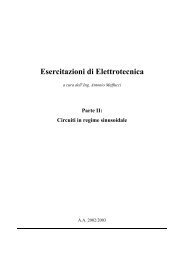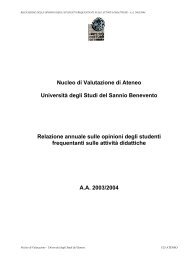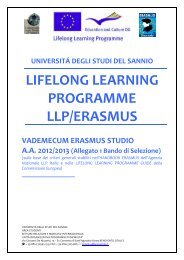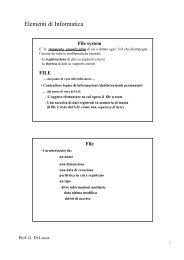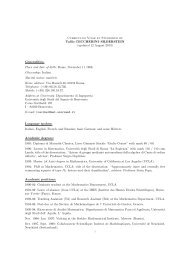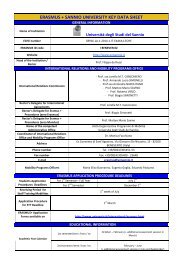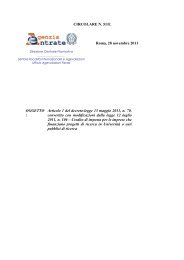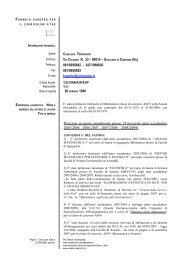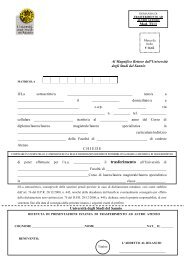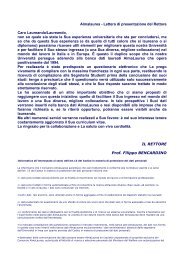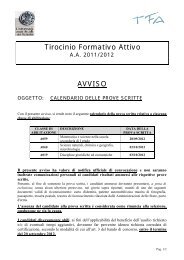BENVENUTI A BENEVENTO / WELCOME TO BENEVENTOvisibili all’interno <strong>del</strong>le mura <strong>del</strong>la città, a testimonianza<strong>del</strong> glorioso passato.I monumenti più significativi di questo periodosono: Arco di Traiano, Teatro Romano, Arco detto<strong>del</strong> Sacramento, Ponte Leproso, Ponte Valentino e,inoltre, preziose testimonianze <strong>del</strong> tempio di Iside.ARCO DI TRAIANO - Fu eretto tra il 114 e il 117 d. C. dalSenato e dal Popolo Romano, in onore <strong>del</strong>l’ImperatoreTraiano, all’inizio <strong>del</strong>la Via Traiana che abbreviavail percorso da Benevento a Brindisi.È tra i più insigni monumenti <strong>del</strong>l’arte romana.Le sue varie sculture si riferiscono alle benemerenzesociali <strong>del</strong>l’imperatore verso Roma, verso le Provincee verso la città di Benevento. È alto m. 15,60,con il fornice alto m. 8,60. Il suo stato di conservazioneè perfetto. Nel Medio Evo fu la principale porta<strong>del</strong>la città, denominata “Port’Aurea”, in seguitofatta isolare da Papa Pio IX.TEATRO ROMANO - Ha un diametro di 90 metri econserva il primo e parte <strong>del</strong> secondo dei tre ordinidi venticinque arcate che lo componevano. È tra i teatriantichi conservati uno dei più grandi e più belli.La sua costruzione risale dall’epoca di Adriano. Fupoi restaurato da Caracalla.ARCO DETTO DEL SACRAMENTO - Notevole monumento<strong>del</strong>l’epoca romana di età post-traianea. Èsorretto da pilastri in mattoni, <strong>del</strong> diametro di cinquemetri, con nicchie per statue. Prende il nomeda una vicina cappella <strong>del</strong> Sacramento, distrutta daibombardamenti <strong>del</strong> settembre 1943.PONTE LEPROSO - Per questo ponte, che prende ilnome da un lebbrosario che doveva esistere nellevicinanze, la Via Appia entrava in Benevento. Sottole quattro arcate (un tempo cinque) scorre il fiumeSabato che ricorda le antiche leggende <strong>del</strong>le stregheimpegnate in folli Sarabande sulle sue rive,sotto un vecchio noce. Nei pressi di detto ponte èubicato il settecentesco immobile “Mulino Pacifico”che viene utilizzato per iniziative culturali.PERIODO LONGOBARDOLa caduta <strong>del</strong>l’Impero Romano segnò un periododi decadenza anche per Benevento, che assurse anuova gloria sotto la dominazione dei Longobardi.Benevento, all’inizio di questa dominazione(571), con Zottone I, fu un Ducato; poi, in seguitoalla caduta <strong>del</strong> Regno di Pavia (774), fu elevata aPrincipato da Arechi II. Questi, amante <strong>del</strong>le arti e<strong>del</strong>la cultura, realizzò numerose opere architettoniche,come l’ampliamento <strong>del</strong>la cinta muraria, conla creazione <strong>del</strong>la Cìvitas nova (attuale Triggio), laThe most remarkable monuments from this periodare: “Arco di Traiano”, the Roman Theatre, theso called Arch of the “Sacramento”, Leproso Bridge,Valentino Bridge and precious evidence of the templeof Isis.ARCO DI TRAIANO - Built between 144 and 117 ADby the Senate and the Roman People as a tributeto Emperor Traiano, at the beginning of Via Traianawhich shortened the route from Benevento to Brindisi.The arch is one of the most important recordsof Roman art. The various sculptures refer to the goalshe achieved in Rome, in the Province and in thetown of Benevento. It’s 15.6 metres high with a 8.6metres barrel vault. It’s perfectly preserved, thanksto recent consolidation and restoration works. Inthe Middle Ages, it was the town’s main gate, called“Porta Aurea”, later isolated by Pope Pius IX.THE ROMAN THEATRE - The theatre has a diameterof 90 metres and preserves the first and part ofthe second of the three tiers of twenty-five archesthat formed it. It is one of the largest and finest ancienttheatres that still exist. It was built during Hadrian’stimes and later restored by Caracalla.THE ARCH OF THE “SACRAMENTO” - Notable Romanmonument from the post Traiano period. It isbuilt on brick pillars with a diameter of five metresand has niches for statues. It takes its name fromthe nearby Chapel of the Sacramento, destroyed bythe bombings in September 1943.LEPROSO BRIDGE - Via Appia entered Beneventoby this bridge, which takes its name from a leperhospital that was located nearby. The river Sabato,flowing under its four arches (once five), recallsancient legends of witches who danced moonlitsarabands on its banks, under an old walnut tree.“Mulino Pacifico” is located near the bridge. Builtin the 18th century and recently restored, it is nowused for cultural activities.THE Longobard PERIODThe fall of the Roman Empire marked a period ofdecline also in Benevento, which rose to new gloryunder the Longobard domination.At the beginning of this domination (571), underZottone I, Benevento was a duchy; then, followingthe fall of the Kingdom of Pavia (774), it was turnedinto a Principality by Arechi II. Arechi, being passionateabout art and culture, built many architecturalworks, like the extention of the town walls after creatingthe Civitas nova (now the Triggio), St. Sophia’sChurch and the Benedictine monastery with its fine54
Monetazione longobarda / Longobard CoinBENVENUTI A BENEVENTO / WELCOME TO BENEVENTONel logo <strong>del</strong>l’<strong>Università</strong> <strong>del</strong> <strong>Sannio</strong> unamoneta d’oro <strong>del</strong>la Zecca longobarda di Beneventoraffigura il volto <strong>del</strong> duca Arechi II. Neiterritori <strong>del</strong> Regno longobardo, a partire dal568 d.C., si impose abbastanza rapidamentel’uso di monete in oro di imitazione bizantina,prodotte nella zecca regia di Pavia. Carattereparticolare ebbero le monetazioni <strong>del</strong>la Tusciae <strong>del</strong> Ducato di Benevento. A Beneventoi Duchi longobardi emisero solidi e tremissidi tipo bizantino contrassegnati, a partire dalregno di Gisulfo I (689-706), dalle proprie iniziali.L’attività <strong>del</strong>la zecca di Benevento continuòa lungo anche dopo la sconfitta <strong>del</strong> reDesiderio e la fine <strong>del</strong> Regno.In particolare, il logo di Unisannio raffigurauna tremisse aurea di Arechi II (774-787) coniatanella zecca di Benevento.Il principe, fondatore <strong>del</strong>la celebre abbaziadi Santa Sofia, porta sulla spalla destra ilsimbolo <strong>del</strong> potere, una fibula costituita da undisco principale, tre pendenti a cinque maglieciascuno, gemme a goccia terminali.Una curiosità: le popolazione barbaricheinterpretavano le monete <strong>del</strong>le culture concui venivano in contatto esclusivamente qualielementi preziosi e decorativi; tale tendenzaportava spesso all’inserimento <strong>del</strong>la monetain monili e oggetti di pregio, snaturandone lafunzione.The logo of the University of <strong>Sannio</strong> is agold coin of the Longobard mint of Beneventorepresenting the duke Arechi II’s face. In theterritories of the Lombard kingdom, from the568 B.C., the use of golden coins quickly spreadin imitation of the Byzantine coins, producedin the regal mint in Pavia. The coinagesof the Tuscia and the Dukedom of Beneventowere particularly characteristic. In Benevento,the Lombard Dukes issued solidi and tremissiin the Byzantine way, marked, beginning fromthe kingdom of Gisulfo I (689 -706), with theirinitials.The activity of the mint of Benevento alsocontinued for a long time after king Desiderio’sdefeat and the end of the Kingdom.Particularly, the logo of Unisannio representsa golden tremisse of Arechi II (774 -787)coined in the mint of Benevento. The prince,founder of the famous abbey of Saint Sofia,hands on the right shoulder the symbol of thepower, a fibula constituted by a main disk, threependants and gems.A curiosity: the barbaric population consideredthe coins only precious and decorativeelements; indeed, coins were inserted intonecklaces and valuable objects.Tremisse d’oro di Arechi II (758 - 788 d.C.)Gold tremissis of Arechi II (758 - 788 BC)55



